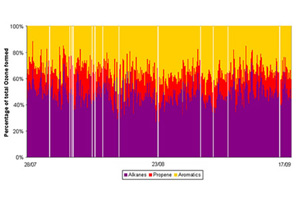Rate Coefficients for the Gas-Phase Oxidation Reactions of Unsaturated Hydrocarbons with OH, NO3 and O3

Global non-methane hydrocarbon (NMHC) fluxes are dominated by alkene emissions, mainly of biogenic origin. Given their photolytic stability, low solubility and reactivity towards atmospheric oxidants, free radical abstraction, addition and ozonolysis reactions represent major sinks for alkenes in both daytime and nighttime tropospheric conditions. As with other NMHCs, alkene oxidation is integral to in situ tropospheric ozone production and as a result of enhanced fluxes and reactivity relative to saturated hydrocarbons, alkene oxidation is dominant among local scale tropospheric ozone production processes.
The reaction of OH with an alkene has been assumed to proceed via a simple addition reaction; however, there is the possibility that hydrogen abstraction may contribute to alkene reactivity as the side chain length increases as suggested by Atkinson. Alkenes are therefore compounds where the reaction with OH can be considered as an addition to the double bond with a contribution of the hydrogen abstraction reaction pathway to the overall rate coefficient. Abstraction will range from being of minor to major importance. Recent theoretical studies indicate that hydrogen abstraction reactions with >CH-, -CH2- and -CH3 groups will occur; however there are virtually no direct experimental results to support this hypothesis.
In the Earth’s troposphere, hydroxyl (OH) radicals attack a variety of Non Methane Hydrocarbons (NMHCs) compounds released naturally and anthropogenically. The attack thus initiates the oxidation and degradation of a large number of species.